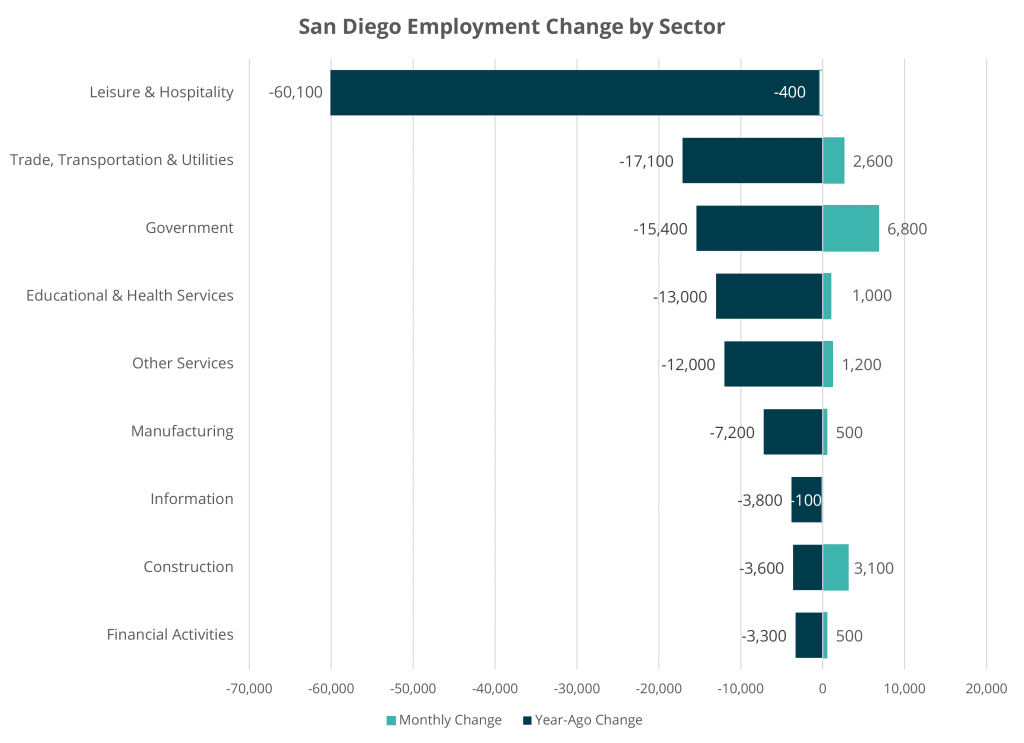Each month the California Employment Development Department (EDD) releases employment data for the prior month. This edition of San Diego’s Economic Pulse covers August 2020 and reflects some effects of the coronavirus pandemic on the labor market. Check out EDC’s research bureau for more data and stats about San Diego’s economy.
Key Takeaways
- Unemployment drops sharply to 9.9 percent; remains highest in the unincorporated parts of the County.
- Employment up in nearly all industries, up 20,500 jobs month over month.
- Low-wage job losses are nearly 30 times greater than high-wage job losses.
Unemployment Drops
The region’s unemployment rate was 9.9 percent in August down from a revised 12.4 percent in July 2020, and far above the year-ago estimate of 3.4 percent. Unemployment declined monthly as the region continues to reopen and jobs recover. San Diego’s unemployment rate remains lower than the state unemployment rate of 11.6 percent, but higher than the national unemployment rate of 8.5 percent.
Unemployment was highest in the unincorporated areas of Bostonia (17.9%), Bonita (14.7%), Spring Valley (13.6%), and in the cities of National City (13.7%) and El Cajon (13.6%), and lowest in the cities of Solana Beach (5.5%), Poway (6.8%), Coronado (6.8%), Del Mar (7.3%), and Encinitas (7.3%). Wealthier areas are enjoying lower rates of unemployment, while neighborhoods with a larger share of lower-paid workers suffer from higher rates of unemployment – elaborated on below.
Employment Bounces Back
Total nonfarm employment increased in August, up 20,500 jobs. This follows similar patterns to the state and national data. In California, nonfarm employment increased by 140,400 in August from the month prior, while payroll employment increased by 1.4 million in the U.S. during the same time period.
However, compared to a year ago, San Diego nonfarm employment remains down 135,800 jobs or 9 percent. In California, total nonfarm employment is down 1.6 million jobs, or 8 percent compared to a year ago, while the U.S. is down nearly 13 million jobs, or 8.8 percent.
Sector Employment Gradually Returning
Government accounted for the largest monthly gains, adding 6,800 jobs in August, primarily concentrated in local government education (up 4,300 jobs) after last month’s large decline. Compared to a year ago, local government education is still down 11,400 jobs.
Professional and business services followed with an increase of 5,300 jobs. Most of those job gains were in the administration and support services sector, which added 3,100 jobs to the region.
Construction employment increased this month, adding 3,100 jobs.
Trade, transportation, and utilities employment increased this month, adding 2,600 jobs. This was driven primarily by retail, which added 2,300 jobs.
Leisure and hospitality employment as a whole declined by 400 jobs in August. Encouragingly, however, restaurants added 700 jobs last month amid measured reopenings across the region.
Recovery Must Focus on Low-Wage Workers
Despite the gains observed in August, industry employment remains well below levels a year ago. The largest decline in employment has been in leisure and hospitality, which is down 60,100 jobs (shown in the chart above), or 29 percent since August 2019. Most of those leisure and hospitality job losses are concentrated in accommodation and food services, with a loss of 43,900 jobs. Trade, transportation, and utilities are down 17,100 jobs, with 11,700 of those jobs in retail. Government is down 15,400 jobs annually, with 14,000 local government jobs lost.
The lowest wages in San Diego County are concentrated in the sectors hardest hit by COVID-19: accommodation and food services, retail trade, arts, entertainment, and recreation, and educational services. Average wages for accommodation and food services are $30,560, retail trade are $41,785, arts, entertainment, and recreation are $45,040, and educational services are $49,826. Each sector hit hardest by COVID19 falls below the median regional wage of $73,596.
Layoffs in low-wage sectors have occurred at a rate much higher than those in high-wage sectors. According to Opportunity Insights, low wage jobs are down 31.8 percent. Meanwhile, high wage jobs are down only 1.8 percent.
Consumer spending has also suffered as wages continue to drop, especially for lower-wage employees. While low-wage workers hold less spending power, they spend more of their paychecks directly, rather than investments or savings. We can expect to see a larger proportion of spending come back into the economy as lower-paid employees get their jobs back, and ultimately advance to better paying positions over time.
Every previous economic recovery has increased systemic poverty and widened inequality. Too often in a rush to restore normalcy, entire segments of our community have been left further behind. The stakes could not be higher that we get this recovery right. We must rebuild an economy that is more resilient than before, so prosperity reaches more people. Read more about EDC’s recovery framework.
EDC is here to help. You can use the button below to request our assistance with finding information, applying to relief programs, and more.
You also might like:
